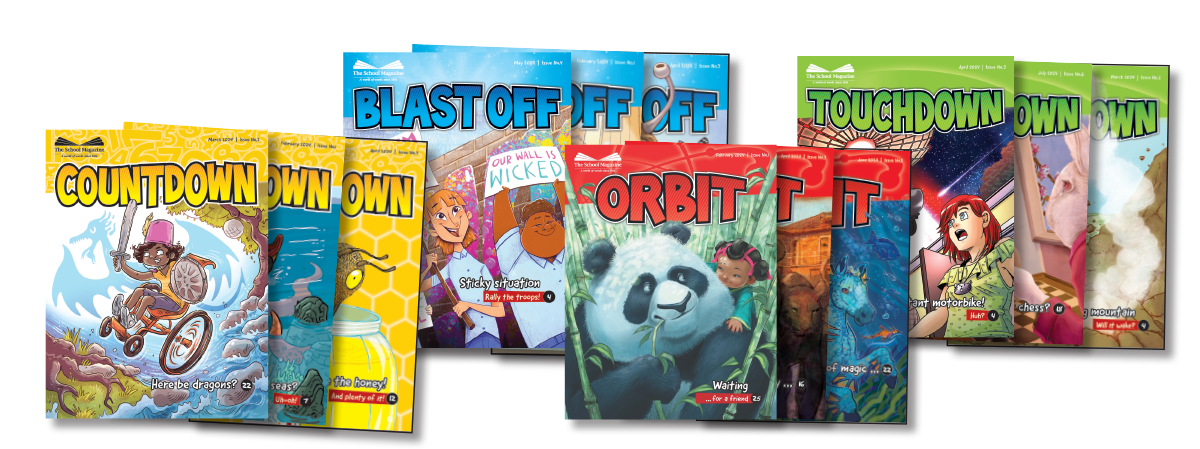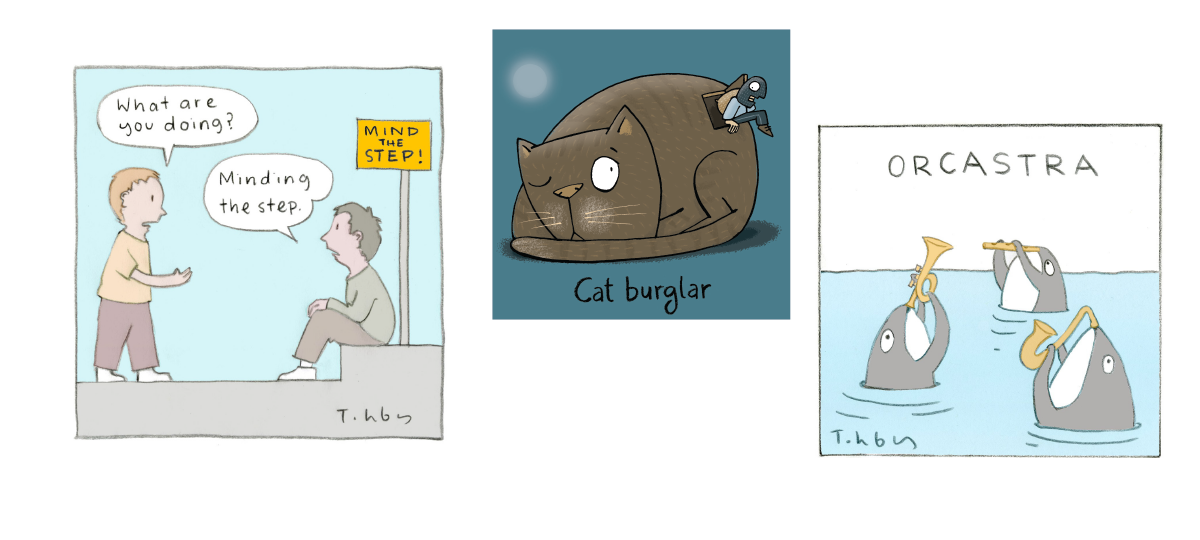Contributor Guide
Magazine Age Guide
Our magazines
The School Magazine produces four magazines catering to different ages and reading levels. Familiarising yourself with these can help you confirm where your piece might fit best.

Countdown – Year 3
- Ages 7-9
- Inspires and captivates newly independent readers
Blast Off – Year 4
- Ages 9-10
- Delights independent readers, consolidating their knowledge of English
Orbit – Year 5
- Ages 10-11
- Captures the imagination of skilled readers through crafted texts and engaging illustrations
Touchdown – Year 6
- Ages 11+
- Delivers a rich array of texts, allowing capable readers to explore the world of literature
Factors that impact the suitability of a piece for each magazine level include:
Length and difficulty
In general, Countdown and Blast Off feature shorter fiction pieces under 1,200 words. As readers become more independent and confident, they can tackle longer pieces in Orbit and Touchdown.
Our younger levels also tend to feature simpler words and sentence structure.
Content
Ensure the content of your piece is age appropriate. Children often enjoy reading about protagonists their own age or a few years older. For example, pieces set in high school won’t resonate with Countdown readers. Pieces that are too simple or better suited to a picture book are too young for our readership.
While difficult or complex topics can be written about with sensitivity and deftness, it is always worth keeping the age of the reader in mind and considering whether or not your work could confidently be read and appreciated in a primary classroom.
As a general rule, topics that would require a content warning are not suitable for The School Magazine.
Novelty
We are always looking for novel and original ideas to present in the magazine. Reading through recent issues, including the free issues offered online, will give you a feel for the type of topics we cover.
However, age suitability does factor into these decisions. For example, if we’ve covered a particular topic at a Touchdown level, but you have approached it in a way more accessible for younger audiences, we may consider running the piece despite its similarities to previously published material.
Relevance
Write for our readers. Most are Australian children between the ages of 8 and 12. Remember that The School Magazine aims to reflect the diversity and inclusivity of Australian society.
While we are always interested in stories that portray and reflect other cultures, be sure these ideas are still accessible and relevant for an Australian audience—particularly if your story is set in a school.
Writing Advice
The School Magazine publishes short stories, articles, plays, poems, persuasives, comics and activities that have literary and academic merit. Our readers are primary school children who respond well to texts that delight, intrigue, challenge and inspire them—texts written especially for them. In this next section you’ll find the requirements for each text type, as well as tips from our editorial team.
Stories

Submission guidelines
- All genres welcome.
- Maximum ~1,500 words (shorter stories are encouraged).
- Stories should demonstrate clear, intriguing prose, originality of characters and fresh storylines.
- Occasionally a longer story may be considered for serialisation. If proposing a two-part story, clearly indicate where the break would sit.
General writing tips
1. Remember child voice and agency
The child reader is at the heart of what we do. They want to see themselves within the pages of our magazines.
2. Choose your angle and setting
Our readers live in a multicultural, diverse society and our magazines reflect this. Our readers are exploring their identities and appreciate insights into the world around them. Genres are also great gateways into other worlds.
3. Cut to the chase
Get to the action, drama or tension as quickly as you can. Pacing and structure are important, so make sure every word counts. Make use of the unexpected, twists and turns to keep young readers eager to turn the pages.
4. Authenticity is key
We want authentic representation. Think about the sights, sounds and flavours you are surrounded by every day. Think about authentic expressions, traditions, and community. No stereotypes or clichés, please!
Watchouts
1. Too didactic
We all learn lessons from stories, but if these lessons are too forced or on-the-nose, they can read more like lectures than fiction. Trust young readers to interpret their own meaning from a story.
2. Read the room
Have a clear idea in mind of the age you’re writing for and avoid themes or imagery that’s too mature, violent or inappropriate. You should also have a clear understanding of a publication’s guidelines before you submit.
3. Choose your words
Word choice and correct grammar usage can have a huge impact on young readers’ understanding. Familarise yourself with the language used in books aimed at your target audience and proofread for clarity.
Articles
Submission guidelines
- All forms of soundly researched non-fiction texts are accepted, including articles, procedural texts, reports, profiles, interviews, short features and non-fiction narratives.
- Maximum ~2,000 words (shorter articles are also accepted).
General writing tips
1. Super subs
Subheadings can be useful in any non-fiction piece, but especially those written for kids. They can help them scan, process and better follow the flow of information.
2. Short and sharp
You can make your pieces more approachable and engaging for young readers by keeping them succinct and using a strong voice. Also remember we feature a mix of one-page articles and longer pieces.
3. Fresh and evergreen
Differentiate your piece from a dry textbook excerpt by taking a fresh angle on a familiar topic or looking at one that’s a little quirky. Try to avoid topics that may quickly become dated.
4. Format fun
Have some fun with the format and choose something that makes your information shine. Is it a recipe? A police report? An interview done under the sea? Creativity is always welcome.
5. Researched and ready
Make sure your information is as correct and up-to-date as possible, and feel free to include your sources in your submission so the editorial team can validate them.
Watchouts
1. Well-worn topics
Keep in mind topics we’ve covered recently and be aware that some topics (e.g. a profile on an animal or very famous figure from history) may be something we’ve covered extensively before.
2. Too dry
Avoid overly complex writing that is difficult to parse or includes extraneous detail that detracts from the pace and energy of the piece. Try reading your article aloud to catch these sections during your edits.
Poetry

Submission guidelines
- Poems can be in any contemporary or traditional genre.
- Maximum of thirty lines.
- Each poem should be submitted as an individual contribution.
- If using traditional metre and rhyme, ensure that the metre is consistent and the rhyme unforced.
- When punctuating, keep in mind the developing skills of the young poetry reading audience.
General writing tips
1. More than rhyme
We love a good rhyming poem, but we also love the full range of poetry forms available. Shape poems, free verse, haiku—all poetry types are welcome.
2. Watch your length
Your poem should only be as long as it needs to be. Beware the saggy middle or dragging a poem out longer than it needs to be, particularly when you’re using repetition.
3. Feel the rhythm
Read your work aloud before submitting. Listen closely for metre, cadence and rhythm—especially when using rhyme. It can be easy to sneak in a few too many syllables by accident!
4. Be bold!
The ocean, sunsets and the wind through the trees inspire many a poem, but we’re interested in all topics! Try something new, ruminate on something strange, make us think!
Watchouts
1. Age appropriate
Ensure your topics and ideas have appeal for our target audience. This isn’t just limited to avoiding overtly adult themes; our readers are often looking for something more complicated than simple picture-book style rhymes.
2. Huh?
We love all the techniques utilised to make poetry the beautiful art form that it is, but keep in mind many of our readers are new to the form. Avoid anything too complex or esoteric.
Plays
Submission guidelines
- Plays should be easy-to-stage scripts for large groups of students to perform, although plays for smaller casts are also welcome.
- Maximum of ~1,500 words (fewer for younger readers).
- Scripts should have literary qualities in characterisation, language and plot.
General writing tips
1. Everybody in!
Plays are often used in classrooms, so consider including some roles that can be played by multiple kids. It involves more of the class and can encourage less confident children to participate.
2. Support staging
Make your plays easy to stage in classrooms by considering safety concerns and the difficulty to source or make props. You can also help by offering creative ideas or solutions for staging in the text.
3. Story first
Even though a play is a different format to a story, it should still have a clear beginning, middle and end. Avoid scenes that don’t contain any change to characters or plot.
4. First timers
Plays with multiple Acts or Scenes may be overwhelming for our youngest performers! Keep in mind the age you’re writing for when considering the length and complexity of your text.
Watchouts
1. Retellings
Retellings can be a lot of fun but over the years we’ve received an influx of fractured fairytales! For your best chance at publication, original stories work best or, if you are retelling a classic, make sure it has a fun new twist!
2. How do you say ...?
If there are any words in your play that may be difficult for young readers to pronounce, think about including them phonetically in the text to help children when they’re performing.
Persuasives
Submission guidelines
- Persuasives can be in any format or genre so long as they exhibit elements of persuasion (credibility, emotional appeal and logical argument).
- Shorter lengths are encouraged.
General writing tips
1. Show off your expertise
Spend time considering what you might call yourself an expert in. Write a logical and analytical piece about your topic using your expertise and insight to strengthen your argument.
2. Think outside the box
Persuasive texts don’t have to be essays. Explore the full range of text types available: political speeches, letters, keynotes, reviews, advertising campaigns etc.
3. Have a dynamo discussion
Perhaps you prefer a pleasant discussion, exploring all the avenues and perspectives. Discussions are a great way to create thought-provoking persuasive texts.
4. Explore new perspectives
Think about presenting the unheard voice or a previously unconsidered perspective. Make us think about a topic from a point of view that we’ve never considered before.
5. Know thy audience
Being young doesn’t mean primary-aged children aren’t prepared and interested in discussing hard-hitting topics. Analyse, argue and discuss the world they live in, in a considered and thoughtful way.
Watchouts
1. Same old
Beware the kind of standard persuasives given to students in class, for example ‘Should students wear uniforms?’. Search online to find the topics students are probably already well-versed in.
2. Suitability
Remember these texts are being used in classrooms across the country. Topics should be relatable to all students and cater to diversity in culture, interest and maturity.
Activities
Submission guidelines
- The majority of activities and puzzles are generated in-house, but texts are also accepted from external writers.
General writing tips
1. Paired works
Activities that are paired with other submitted work, such as an article or story, are easier to place. For example, if you wrote an article about code-breaking, a code-writing activity might be appropriate.
2. Fun formats
Activities that are particularly creative or novel have a higher chance of being selected. We have a talented stable of illustrators who can help bring any format to life.
3. Relevant and accessible
Our readers are primary-aged students. Activities that are too difficult or require too much money or labour to complete are unlikely to be selected.
Watchouts
1. Not school
Our magazine is a support for classrooms, but its primary goal is to encourage a love of reading. We don’t publish worksheets or activities that aim to cover literacy lessons.
Comic Serials
Submission guidelines
- We call for comic serial submissions once a year, usually around April/May.
- We accept either a single-page serial in ten parts or a double-page serial in ten parts.
- Submissions should include a written synopsis of the comic serial, including episode breakdowns, episode 1 to finished art stage (page dimensions are 185mm x 240mm) and a character sheet with rough or finished art, introducing key characters.
General writing tips
1. All genres welcome
We publish comic serials that cover fantasy, humour, folktales, historical drama, sci-fi and a mixture of these genres.
2. Keep readers hooked
There’s a month between issues, so every episode of your serial should end in a way that leaves the reader wanting more and eager for their next instalment.
3. Polished art
Familiarise yourself with past examples of our comics. We have high expectations of polish and formatting for our comics as they’re often what readers will see first on the back cover.
4. Action and whimsy
We’re after dynamic, fun stories that utilise and benefit from being in a visual medium. Have fun with it!
5. Teams welcome
You don’t have to do it all alone! We accept writer/artist duo submissions as well.
Watchouts
1. Appropriate visuals
Our magazines are used in classrooms and should contain visuals that are suitable for readers between 7-12. Keep this in mind when portraying violence, romance etc.
2. Open to feedback
Our editorial team may have feedback on the arc of your serial or some of the portrayals. While the creative vision is ultimately yours, being open to feedback and communication is a highly-desirable quality.
Cartoons

Submission guidelines
- We are open to single-panel cartoons but have limited spots available each year.
- They must be original work, created in a square format (120mm x 120mm minimum size) in CMYK (300 dpi minimum).
General writing tips
1. Wordplay welcome
We encourage the use of puns and wordplay to appeal to children and be easily understandable within such small real estate.
2. Show, don’t tell
We’ve found that the most successful cartoons have more ‘showing’ than ‘telling’. Avoid jokes that need to be overexplained or contextualised.
3. Bite-sized beauty
Our cartoons are small inserts in the magazine that pack a punch. Try to ensure your work either makes a reader laugh or think.
Watchouts
1. This is not The New Yorker
Our readers are in primary school. Sometimes we get submissions that, while undeniably clever, are written for an adult audience. Make sure your work is accessible and fun for kids!
Alumni Corner
Over the years, The School Magazine has hosted a wealth of talented writers, including Anna Fienberg, Geoffrey McSkimming, Ursula Dubosarsky and Pamela Freeman. Some of our most prolific contributors have kindly offered some advice for new and emerging writers.
Our Thanks
To the contributors who submit their pieces to our magazine, and to the writers and artists who let us feature their work in this guide. In order of appearance:
Writers featured
- Bill Condon
- Darcy-Lee Tindale
- Jackie Hosking
- Katie Furze
- Stephen Whiteside
- Janeen Brian
- David Hill
- Zoë Disher
- Wendy Graham
- Simon Cooke
- Ursula Dubosarsky
Illustrators featured
- Anna Bron
- Greg Holfeld
- Christopher Nielsen
- Dante Hookey
- Sylvia Morris
- Tohby Riddle
- Michel Streich